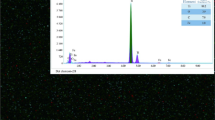Abstract
During fly cutting of large aperture flat optical components, mid-spatial frequency micro-waviness is formed on the machined surface, which greatly affects the optical performance of the components. This study aims to explore the mechanism of formation of micro-waviness perpendicular to the feed direction, which is called longitudinal micro-waviness (LMW). A finite element model (FEM) of the ultra-precision fly cutting spindle system is developed to analyze the axial vibrations of the tool nose. The analysis shows that the formation of LMW is the result of coupling of the response of the spindle system and its higher order natural frequency response under the excitation of the tangential cutting force. The vibration frequency of the tool nose is closely related to the structure of the spindle system. By changing the stiffness of the cutting head, the frequency is significantly changed, and the LMW formed on the machined surfaces has a spatial period of 39.2 mm, which is out of the range of mid-spatial frequency waviness. This result has great significance in the design of fly cutting machines, and can be used to improve the quality of the optical surface and thereby improve the performance of large aperture flat optical devices.
Similar content being viewed by others
References
Wang X, Gao H, Chen Y, Guo D (2015) A water dissolution method for removing micro-waviness caused by spdt process on kdp crystals. Int J Ad Manufacturing Technol 85(5):1–14
Hou N, Zhang Y, Zhang L, Zhang F (2016) Assessing microstructure changes in potassium dihydrogen phosphate crystals induced by mechanical stresses. Scr Mater 113:48–50. https://doi.org/10.1016/j.scriptamat.2015.10.002
Hawley-Fedder RA, Geraghty P, Locke SN, McBurney MS, Runkel MJ, Suratwala TI, Whitman PK (2004) NIF pockels cell and frequency conversion crystals. In Proceedings of SPIE 5341(1):121–126
Zhang Y, Zhang L, Liu M, Zhang F, Mylvaganam K, Liu W (2015) Understanding the friction and wear of kdp crystals by nanoscratching. Wear 332–333:900–906
Wang S-F, Fu P-Q, Zhang F-H, An C-H et al (2014) Investigation of surface micro-waviness in single point diamond fly cutting. J Harbin Inst Technol ( New Series) 21(5):119–123
Chen M, Li M, Jiang W, Xu Q (2010) Influence of period and amplitude of microwaviness on kh2po4 crystal’s laser damage threshold. J Appl Phys 108(4):478–279
Chen M, Li M, Cheng J, Jiang W, Wang J, Xu Q (2011) Study on characteristic parameters influencing laser-induced damage threshold of kh(2)po(4) crystal surface machined by single point diamond turning. J Appl Phys 110(11):113103–1131037. https://doi.org/10.1063/1.3664692
Chen M, Jiang W, Pang Q, Liu X (2010) Simulation of micro-nano processing induced surface defects influencing kdp laser damage threshold. High Power Laser Particle Beams 22(1):159–164. https://doi.org/10.3788/HPLPB20102201.0159
Lee WB, Cheung CFA (2001) Dynamic surface topography model for the prediction of nano-surface generation in ultra-precision machining. Int J Mech Sci 43(4):961–991. https://doi.org/10.1016/S0020-7403(00)00050-3
Lee WB, Cheung CF, To, S (1999) Materials induced vibration in ultra-precision machining. J Mater Process Technol 89–90(8):318–325
Cheung CF, Lee WB (2001) Characterisation of nanosurface generation in single-point diamond turning. Int J Mach Tool Manu 41(6):851–875. https://doi.org/10.1016/S0890-6955(00)00102-4
Wang CC, Jang MJ, Yeh YL (2007) Bifurcation and nonlinear dynamic analysis of a flexible rotor supported by relative short gas journal bearings. Chaos, Solitons Fractals 32(2):566–582. https://doi.org/10.1016/j.chaos.2005.10.098
Wang CC, Yau HT, Jang MJ, Yeh YL (2007) Theoretical analysis of the non-linear behavior of a flexible rotor supported by herringbone grooved gas journal bearings. Tribol Int 40(3):533–541. https://doi.org/10.1016/j.triboint.2006.05.004
Chen D, Fan J, Zhang F (2012) Dynamic and static characteristics of a hydrostatic spindle for machine tools. J Manuf Syst 31(1):26–33. https://doi.org/10.1016/j.jmsy.2010.11.006
Ni J (1985) Dynamic stability and debugging of aerostatic-pressurized bearings in magnetic disk comprehensive instrumentation. J Huazhong Univ Sci Technolog Med Sci 13(3):69–74
Khanfir H, Bonis M, Revel P (2005) Improving waviness in ultra precision turning by optimizing the dynamic behavior of a spindle with magnetic bearings. Int J Mach Tool Manu 45(7–8):841–848. https://doi.org/10.1016/j.ijmachtools.2004.11.007
Frew DA, Scheffer C (2008) Numerical modelling of a high-speed rigid rotor in a single-aerostatic bearing using modified Euler equations of motion. Mech Syst Signal Process 22(1):133–154. https://doi.org/10.1016/j.ymssp.2007.06.008
Takasu S, Masuda M, Nishiguchi T, Kobayashi A (1985) Influence of study vibration with small amplitude upon surface roughness in diamond machining. CIRP Ann Manuf Technol 34(1):463–467. https://doi.org/10.1016/S0007-8506(07)61812-5
Cheung CF, Lee WB (2000) A theoretical and experimental investigation of surface roughness formation in ultra-precision diamond turning. Int J Mach Tool Manu 40(7):979–1002. https://doi.org/10.1016/S0890-6955(99)00103-0
An CH, Zhang Y, Xu Q, Zhang FH, Zhang JF, Zhang LJ, Wang JH (2010) Modeling of dynamic characteristic of the aerostatic bearing spindle in an ultra-precision fly cutting machine. Int J Mach Tool Manu 50(4):374–385. https://doi.org/10.1016/j.ijmachtools.2009.11.003
Fu P (2013) Characterization of the effect of fly cutting machine spindle properties on surface waviness and the development of a new dynamic testing system. Master thesis. Harbin Institute of Technology
Zhan l (2015) Simulation and experimental study of KDP crystal surface topography formation in ultra-precision fly cutting machining. Master thesis. Harbin Institute of Technology
Acknowledgements
The authors are grateful to Dr. Pengqiang Hu at the Harbin University of Science and Technology for his invaluable comments and suggestions. This work was financially sponsored by NSFC (Grant No. 51375122) and the Key laboratory foundation of high precision machining (Grant No. ZZ14002).
Author information
Authors and Affiliations
Corresponding author
Rights and permissions
About this article
Cite this article
Wang, M., Zhang, Y., Guo, S. et al. Longitudinal micro-waviness (LMW) formation mechanism on large optical surface during ultra-precision fly cutting. Int J Adv Manuf Technol 95, 4659–4669 (2018). https://doi.org/10.1007/s00170-017-1547-8
Received:
Accepted:
Published:
Issue Date:
DOI: https://doi.org/10.1007/s00170-017-1547-8




